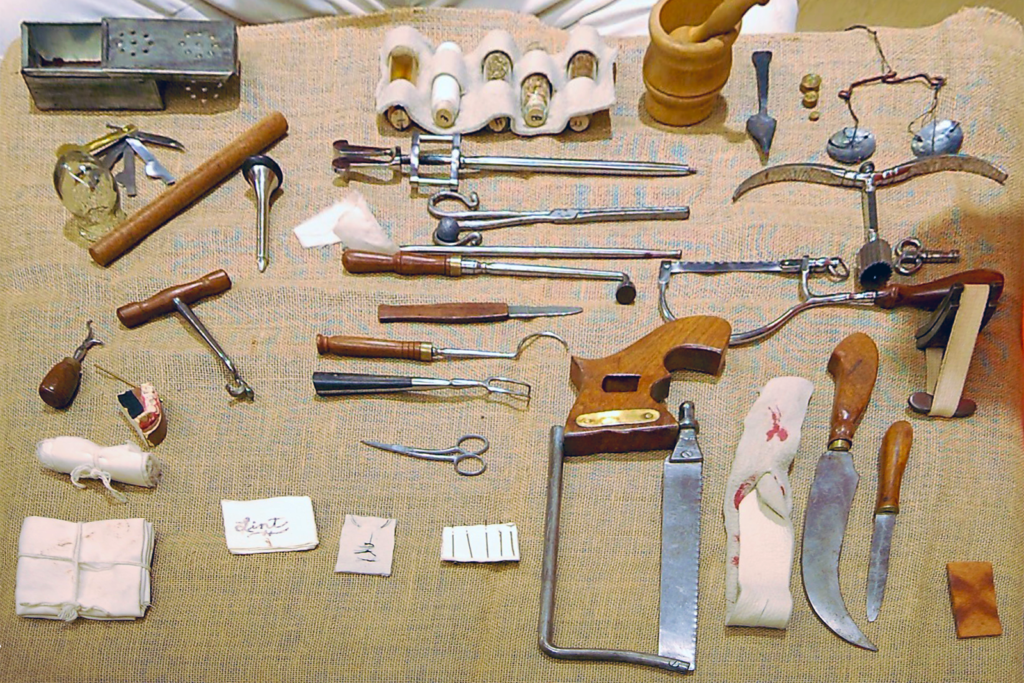Reproductions of Colonial-Era Medical Tools
Imagine all of the uncertainty and anxiety surrounding the COVID-19 pandemic, and then compound it several times over. That will begin to give you a sense of what life was like for the doctors and nurses who tended to the Continental Army.
Their ignorance was perhaps both a blessing and a curse. After, all, you can’t fear what you don’t know exists. Still, death was always looming.
“More people died from disease or infection during the war than from battle wounds, which is counter-intuitive,” says Katherine Becnel, a colonial historian and the volunteer coordinator for the Friends of Washington Crossing Park.
The State of the Art
An estimated 3,500 doctors practiced in the colonies in 1775. Some were trained at The Pennsylvania Hospital, which became America’s first medical college when it opened in Philadelphia in 1768. Two years later, a second, Kings College, opened in New York.
But both accepted only a handful of students, which meant that most doctors received their training through apprenticeships that lasted several years. The nature of their training didn’t matter much, however. “During the war, it was all hands on deck, and that included doctors,” Becnel says.
The doctors of the time knew nothing about bacteria, germs, or viruses, nor the contagious nature of disease. Therefore, their treatments were flawed from the very beginning because they didn’t practice sterilization.
At the same time, doctors and scientists were making observations and asking appropriate questions. For example, Benjamin Rush, Physician General to the Military Hospitals of the United States, among others, observed that cleanliness was a factor in soldiers’ health. But he never fully understood why.
He also advocated for isolating some patients, but that was not a universally recognized need—nor was it always possible. During the Revolutionary War, bedding and sheets weren’t even changed between patients.
Makeshift Medical Care
Anyone with medical knowledge was pressed into service, including countless women who had no formal training but were responsible for their families’ health care. Many were trained by their mothers in how to raise medicinal herbs in their kitchen gardens and how to create remedies from them.
“The doctors could only do so much. That’s where nurses came in,” Becnel says. “Thousands of women followed the army. They were the wives, girlfriends, and daughters of the soldiers. They were paid by the army to do the laundry, but they were nurses, too, though not purely in terms of what we think of a nurse today. They emptied chamber pots, changed bandages, and made sure the living quarters were relatively clean.”
Each regiment had its own doctor, but the level of ability varied widely from one to the next. Most were considered competent. However, only so much was within their control.
They worked in makeshift settings with limited instruments and primitive replacements. Even more, disease ran rampant. Camp conditions were often unsanitary, despite the women’s best efforts. And many of the soldiers were barefoot and dressed in threadbare clothing, even in the dead of winter. Dysentery, fever, and smallpox were common.
The doctors and nurses who tended to the Continental Army were constantly overwhelmed. During the lulls between treating avalanches of wounds caused by musket balls or bayonets, they were caring—unsuccessfully, for the most part—for the camp’s large number of diseased soldiers. All the while, those contagions spread all around them without much interference.
A Silver Lining
Those doctors observed more in a day of battle than they could have in years of peacetime. And that’s been credited with giving new meaning and direction to the medical profession.
It’s difficult to pinpoint specific medical advances that grew out of the war, but it is clear that a growing understanding of how disease spread began to take root during that time.
As Washington Crossing Historic Park’s Soldier Health exhibit notes, Major General Baron von Steuben wrote a training manual in 1778 not long after he joined the Continental Army as a volunteer. The manual, which was used to train the United States Army until 1814, addresses the proper way to set up a camp, including the need to maintain cleanliness and how to care for the sick.


